|
|
|
Sort Order |
|
|
|
Items / Page
|
|
|
|
|
|
|
| Srl | Item |
| 1 |
ID:
111193
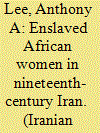

|
|
|
|
|
| Publication |
2012.
|
| Summary/Abstract |
Fezzeh Khanom (c. 1835-82), an African woman, was a slave of Sayyed 'Ali-Mohammad of Shiraz, the Bab. Information about her life can be recovered from various pious Baha'i histories. She was honored, and even venerated by Babis, though she remained subordinate and invisible. The paper makes the encouraging discovery that a history of African slavery in Iran is possible, even at the level of individual biographies. Scholars estimate that between one and two million slaves were exported from Africa to the Indian Ocean trade in the nineteenth century, most to Iranian ports. Some two-thirds of African slaves brought to Iran were women intended as household servants and concubines. An examination of Fezzeh Khanom's life can begin to fill the gaps in our knowledge of enslaved women in Iran. The paper discusses African influences on Iranian culture, especially in wealthy households and in the royal court. The limited value of Western legal distinctions between slavery and freedom when applied to the Muslim world is noted.
|
|
|
|
|
|
|
|
|
|
|
|
|
|
|
|
| 2 |
ID:
111190
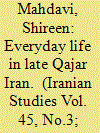

|
|
|
|
|
| Publication |
2012.
|
| Summary/Abstract |
The social history of Iran in general and that of the Qajar era in particular, has been little studied. The subject of this paper, private life in the late Qajar period, has barely been touched upon, probably because it is a subject on which there is not much primary material. There are no comprehensive accounts of people's daily lives of any class or occupation. In this article an attempt is made to give an account of the daily domestic life and activities of the household in the Qajar period. As there were major differences between the daily life and households of urban and rural areas, the discussion is limited to urban areas and Shi'i households. The article discusses the roles of the various members of the household as well as the consumption patterns of the family and those from inside or outside the household who catered to its needs.
|
|
|
|
|
|
|
|
|
|
|
|
|
|
|
|
| 3 |
ID:
111189
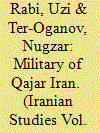

|
|
|
|
|
| Publication |
2012.
|
| Summary/Abstract |
The article examines the parameters of the irregular army in Qajar Iran, including its assembly, numbers, and provisions, as well as the army's organizational structure: its administration and the divisions of the ad hoc forces (provincial militia and tribal cavalry) and of the standing forces (the shah's bodyguard and artillery corps). Until the creation of the so-called regular army units in Iran at the beginning of the nineteenth century, the irregular army was regarded as the only military force in the service of the Qajar dynasty. Despite the existence of a "regular army," irregular forces, particularly tribal cavalry, continued to play a significant role in Iran's military system throughout the nineteenth century. By understanding the features of the irregular army-its role in Qajar society, its organizational and social structures, its ethnic composition, and other characteristics-we can better understand the character of the state itself.
|
|
|
|
|
|
|
|
|
|
|
|
|
|
|
|
| 4 |
ID:
111188
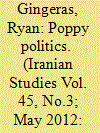

|
|
|
|
|
| Publication |
2012.
|
| Summary/Abstract |
This paper surveys the history of American support for Iranian counter-narcotics policy between 1945 and 1989. In particular, it explores the general failings of Tehran's attempt to ban the domestic production and consumption of opium. The significance of this period is two-fold. First, this essay argues that American-backed efforts to combat the opium trade in Iran highlighted the detrimental effects narcotics had upon both state and society in Iran. Second, it suggests that the Iranian ban upon narcotics helped to stimulate a rise in Afghan opium production before the Soviet invasion of 1979.
|
|
|
|
|
|
|
|
|
|
|
|
|
|
|
|
| 5 |
ID:
111192
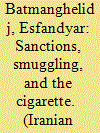

|
|
|
|
|
| Publication |
2012.
|
| Summary/Abstract |
This paper seeks to understand the political economy implications of nicotine addiction in Iran, focusing on the US Office of Foreign Asset Control's granting of Iran operations licenses to American tobacco companies. Presuming that tobacco taxes, levied both as import duties and ad valorem, would financially benefit the Iranian government, the introduction of a highly desired US product to the market would be antithetical to the sanctions regime currently in place. By comparing Iran's tobacco industry, and the attendant public health crisis that has arisen from high rates of nicotine addiction, to conditions in Turkey, it can be demonstrated that Iran is uniquely unable to extract revenues from the sale of tobacco products. The primary point of comparison between Iran and Turkey is smoking-attributable annual productivity losses of each country, as estimated through the use of Smoking-Attributable Mortality, Morbidity and Economic Costs Software (SAMMEC) and the available related literature. According to the calculations derived from the SAMMEC model, Iran is burdened with an astonishing economic cost due to the high prevalence of smokers. It is concluded that an awareness of this condition enables OFAC to award licenses to Big Tobacco without fear of undermining current foreign policy initiatives.
|
|
|
|
|
|
|
|
|
|
|
|
|
|
|
|
| 6 |
ID:
111191
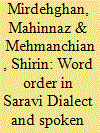

|
|
|
|
|
| Publication |
2012.
|
| Summary/Abstract |
This research is a comparative study of the typological parameters of contemporary spoken Persian language and Saravi, a main dialect of the Mazandarani language, using some Greenbergian universals as its theoretical framework in word order correlations. The study aims to determine the common parameters and the variations of specific syntactic constituents among the systems studied here. On this basis it investigates the unmarked word order in declarations, as well as preparing a systematic comparison of phrasal genitive and adjective structures in the systems under investigation, along with examining their self and possessive pronominal orders. Together with revealing the use of differential orderings within the systems in these respects throughout the paper, the findings uphold Greenberg's language universals as a useful tool in classifying language types as well as specifying the variations of the syntactic constituents.
|
|
|
|
|
|
|
|
|
|
|
|
|
|
|
|
|
|
|
|
|